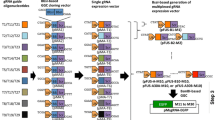Abstract
The RNA-guided CRISPR–Cas9 technology has paved the way for rapid and cost-effective gene editing. However, there is still a great need for effective methods for rapid generation and validation of CRISPR/Cas9 gRNAs. Previously, we have demonstrated that highly efficient generation of multiplexed CRISPR guide RNA (gRNA) expression array can be achieved with Golden Gate Assembly (GGA). Here, we present an optimized and rapid method for generation and validation in less than 1 day of CRISPR gene targeting vectors. The method (LION) is based on ligation of double-stranded gRNA oligos into CRISPR vectors with GGA followed by nucleic acid purification. Using a dual-fluorescent reporter vector (C-Check), T7E1 assay, TIDE assay and a traffic light reporter assay, we proved that the LION-based generation of CRISPR vectors are functionally active, and equivalent to CRISPR plasmids generated by traditional methods. We also tested the activity of LION CRISPR vectors in different human cell types. The LION method presented here advances the rapid functional validation and application of CRISPR system for gene editing and simplified the CRISPR gene-editing procedures.






Similar content being viewed by others
Abbreviations
- CRISPR:
-
Clustered regularly interspaced short palindromic repeats
- Cas9:
-
CRISPR-associated protein 9
- gRNA:
-
Guide RNA
- DSB:
-
DNA double-stranded break
- TIDE:
-
Tracking indels by decomposition
- C-Check:
-
A dual-fluorescent surrogate reporter system for checking CRISPR cleavage activity in vivo
- GGA:
-
Golden Gate Assembly
- LION:
-
LIgation of double-stranded gRNA oligos into CRISPR vector by GGA followed by nucleic acid purificatiON
- SpCas9-RecA:
-
Streptococcus pyogenes Cas9 fused to E. coli recombinant RecA protein
- TLR:
-
Traffic light reporter
- FCM:
-
Flow cytometry
References
Jansen R et al (2002) Identification of genes that are associated with DNA repeats in prokaryotes. Mol Microbiol 43(6):1565–1575
Cong L et al (2013) Multiplex genome engineering using CRISPR/Cas systems. Science 339(6121):819–823
Jinek M et al (2012) A programmable dual-RNA-guided DNA endonuclease in adaptive bacterial immunity. Science 337(6096):816–821
Wang H, La Russa M, Qi LS (2016) CRISPR/Cas9 in genome editing and beyond. Annu Rev Biochem 85:227–264
Mali P et al (2013) RNA-guided human genome engineering via Cas9. Science 339(6121):823–826
Yang L et al (2015) Genome-wide inactivation of porcine endogenous retroviruses (PERVs). Science 350(6264):1101–1104
Niu D et al (2017) Inactivation of porcine endogenous retrovirus in pigs using CRISPR–Cas9. Science 357(6357):1303–1307
Lackner DH et al (2015) A generic strategy for CRISPR–Cas9-mediated gene tagging. Nat Commun 6:10237
Guo D et al (2017) Creating a patient carried Men1 gene point mutation on wild type iPSCs locus mediated by CRISPR/Cas9 and ssODN. Stem Cell Res 18:67–69
Cheng AW et al (2013) Multiplexed activation of endogenous genes by CRISPR-on, an RNA-guided transcriptional activator system. Cell Res 23(10):1163–1171
Liao HK et al (2017) In vivo target gene activation via CRISPR/Cas9-mediated trans-epigenetic modulation. Cell 171(7):1495 e15–1507 e15
Ma H et al (2015) Multicolor CRISPR labeling of chromosomal loci in human cells. Proc Natl Acad Sci USA 112(10):3002–3007
Lin L et al (2018) Genome-wide determination of on-target and off-target characteristics for RNA-guided DNA methylation by dCas9 methyltransferases. Gigascience 7(3):1–19
Gaudelli NM et al (2017) Programmable base editing of A*T to G*C in genomic DNA without DNA cleavage. Nature 551(7681):464–471
Komor AC et al (2017) Improved base excision repair inhibition and bacteriophage Mu Gam protein yields C:G-to-T: A base editors with higher efficiency and product purity. Sci Adv 3(8):eaao4774
Henrik Devitt Møller LL, Xi X, Trine SP, Jinrong H, Luhan Y, Eigil K, Uffe BJ, Xiuqing Z, Xin L, Xun X, Jian W, Huanming Y, George MC, Lars B, Birgitte R, Yonglun L (2018) CRISPR-C: circularization of genes and chromosome by CRISPR in human cells. Nucleic Acids Res 2018:gky767
Jensen KT et al (2017) Chromatin accessibility and guide sequence secondary structure affect CRISPR–Cas9 gene editing efficiency. FEBS Lett 591(13):1892–1901
Bassett AR et al (2014) Highly efficient targeted mutagenesis of Drosophila with the CRISPR/Cas9 system. Cell Rep 6(6):1178–1179
Wang T et al (2014) Genetic screens in human cells using the CRISPR–Cas9 system. Science 343(6166):80–84
Moreno-Mateos MA et al (2015) CRISPRscan: designing highly efficient sgRNAs for CRISPR–Cas9 targeting in vivo. Nat Methods 12(10):982–988
Gagnon JA et al (2014) Efficient mutagenesis by Cas9 protein-mediated oligonucleotide insertion and large-scale assessment of single-guide RNAs. PLoS One 9(5):e98186
Chari R et al (2015) Unraveling CRISPR–Cas9 genome engineering parameters via a library-on-library approach. Nat Methods 12(9):823–826
Lim Y et al (2016) Structural roles of guide RNAs in the nuclease activity of Cas9 endonuclease. Nat Commun 7:13350
Thyme SB et al (2016) Internal guide RNA interactions interfere with Cas9-mediated cleavage. Nat Commun 7:11750
Chen Y et al (2017) Using local chromatin structure to improve CRISPR/Cas9 efficiency in zebrafish. PLoS One 12(8):e0182528
Smith JD et al (2016) Quantitative CRISPR interference screens in yeast identify chemical–genetic interactions and new rules for guide RNA design. Genome Biol 17:45
Liang P et al (2015) CRISPR/Cas9-mediated gene editing in human tripronuclear zygotes. Protein Cell 6(5):363–372
Ruan GX et al (2017) CRISPR/Cas9-mediated genome editing as a therapeutic approach for Leber congenital amaurosis 10. Mol Ther 25(2):331–341
Liang G et al (2016) Selection of highly efficient sgRNAs for CRISPR/Cas9-based plant genome editing. Sci Rep 6:21451
Brinkman EK et al (2014) Easy quantitative assessment of genome editing by sequence trace decomposition. Nucleic Acids Res 42(22):e168
Zhou Y et al (2016) Enhanced genome editing in mammalian cells with a modified dual-fluorescent surrogate system. Cell Mol Life Sci 73(13):2543–2563
Zhang JH et al (2014) Improving the specificity and efficacy of CRISPR/CAS9 and gRNA through target specific DNA reporter. J Biotechnol 189:1–8
Yang Z et al (2015) Fast and sensitive detection of indels induced by precise gene targeting. Nucleic Acids Res 43(9):e59
Rose JC et al (2017) Rapidly inducible Cas9 and DSB-ddPCR to probe editing kinetics. Nat Methods 14(9):891–896
Jewkes R et al (2015) Relationship between single and multiple perpetrator rape perpetration in South Africa: a comparison of risk factors in a population-based sample. BMC Public Health 15:616
Ran FA et al (2013) Genome engineering using the CRISPR–Cas9 system. Nat Protoc 8(11):2281–2308
Doench JG et al (2014) Rational design of highly active sgRNAs for CRISPR–Cas9-mediated gene inactivation. Nat Biotechnol 32(12):1262–1267
Chu VT et al (2015) Increasing the efficiency of homology-directed repair for CRISPR–Cas9-induced precise gene editing in mammalian cells. Nat Biotechnol 33(5):543–548
Vad-Nielsen J et al (2016) Golden Gate Assembly of CRISPR gRNA expression array for simultaneously targeting multiple genes. Cell Mol Life Sci 73(22):4315–4325
Sentmanat MF et al (2018) A survey of validation strategies for CRISPR–Cas9 editing. Sci Rep 8(1):888
Vouillot L, Thelie A, Pollet N (2015) Comparison of T7E1 and surveyor mismatch cleavage assays to detect mutations triggered by engineered nucleases. G3 (Bethesda) 5(3):407–415
Germini D et al (2017) A one-step PCR-based assay to evaluate the efficiency and precision of genomic DNA-editing tools. Mol Ther Methods Clin Dev 5:43–50
Chen X et al (2014) Dual sgRNA-directed gene knockout using CRISPR/Cas9 technology in Caenorhabditis elegans. Sci Rep 4:7581
Paix A et al (2014) Scalable and versatile genome editing using linear DNAs with microhomology to Cas9 Sites in Caenorhabditis elegans. Genetics 198(4):1347–1356
Adikusuma F, Pfitzner C, Thomas PQ (2017) Versatile single-step-assembly CRISPR/Cas9 vectors for dual gRNA expression. PLoS One 12(12):e0187236
Zhen S et al (2017) Inhibition of long non-coding RNA UCA1 by CRISPR/Cas9 attenuated malignant phenotypes of bladder cancer. Oncotarget 8(6):9634–9646
Han J et al (2014) Efficient in vivo deletion of a large imprinted lncRNA by CRISPR/Cas9. RNA Biol 11(7):829–835
Zhang JP et al (2017) Efficient precise knockin with a double cut HDR donor after CRISPR/Cas9-mediated double-stranded DNA cleavage. Genome Biol 18(1):35
Zheng Q et al (2014) Precise gene deletion and replacement using the CRISPR/Cas9 system in human cells. Biotechniques 57(3):115–124
Richardson CD et al (2016) Non-homologous DNA increases gene disruption efficiency by altering DNA repair outcomes. Nat Commun 7:12463
Certo MT et al (2011) Tracking genome engineering outcome at individual DNA breakpoints. Nat Methods 8(8):671–676
Yanik M et al (2018) Development of a reporter system to explore MMEJ in the context of replacing large genomic fragments. Mol Ther Nucleic Acids 11:407–415
Lin L et al (2017) Fusion of SpCas9 to E. coli Rec A protein enhances CRISPR–Cas9 mediated gene knockout in mammalian cells. J Biotechnol 247:42–49
Kuhar R et al (2014) Novel fluorescent genome editing reporters for monitoring DNA repair pathway utilization at endonuclease-induced breaks. Nucleic Acids Res 42(1):e4
Gomez-Cabello D et al (2013) New tools to study DNA double-strand break repair pathway choice. PLoS One 8(10):e77206
Davis L, Maizels N (2014) Homology-directed repair of DNA nicks via pathways distinct from canonical double-strand break repair. Proc Natl Acad Sci USA 111(10):E924–E932
Acknowledgements
We thank Fred Dubee for his generous help with language editing. This project was supported by the Sanming Project of Medicine in Shenzhen (SZSM201612074), BGI-Qingdao, and BGI-Shenzhen. Y.L was partially supported by the Danish Research Council for Independent Research (DFF–1337-00128), the Sapere Aude Young Research Talent Prize (DFF-1335-00763A), and Aarhus University Strategic Grant (AU-iCRISPR). L.L. was supported by the Lundbeck Foundation (R219-2016-1375) and the DFF Sapere Aude Starting Grant (8048-00072A).
Author information
Authors and Affiliations
Corresponding authors
Additional information
Publisher's Note
Springer Nature remains neutral with regard to jurisdictional claims in published maps and institutional affiliations.
Electronic supplementary material
Below is the link to the electronic supplementary material.
Rights and permissions
About this article
Cite this article
Xiang, X., Luo, L., Nodzyński, M. et al. LION: a simple and rapid method to achieve CRISPR gene editing. Cell. Mol. Life Sci. 76, 2633–2645 (2019). https://doi.org/10.1007/s00018-019-03064-x
Received:
Revised:
Accepted:
Published:
Issue Date:
DOI: https://doi.org/10.1007/s00018-019-03064-x




